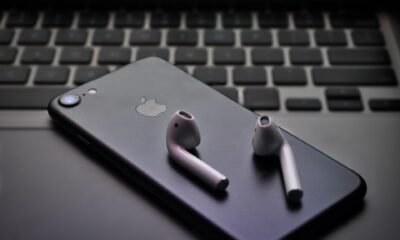Gadgets & Lifestyle Devices
Smartphones without connectors: contactless charging and data transfer technologies
Modern technology is rapidly changing our habits and expectations of gadgets, and smartphones are no exception. One of the most innovative changes that has taken place in recent years is the complete or partial abandonment of traditional connectors in mobile phones. Smartphone contactless charging and data transfer technologies provide users with new opportunities and conveniences, changing the way they use their mobile devices. Increasingly, users are looking for simplicity and benefits – as seen, for example, in the popularity of no deposit bonus offers in the online environment. Technologies that allow charging devices without a physical connection to the network, as well as wireless data transfer, have become one of the most talked about innovations in the world of mobile technology.
Disappearing smartphone connectors are the result of ongoing progress in mobile technology aimed at reducing the number of physical elements and making devices easier to use. They have become an integral part of the evolution of gadgets, improving the user experience. But to what extent are these innovations changing our daily habits, and how do they work?
Ditching connectors: new trends in smartphone design
Current trends in smartphone design mean that traditional physical smartphone connectors are being abandoned. They are being replaced by technologies that allow the transfer of electrical energy and data without direct contact. One of the most important steps in this direction has been the reduction or complete elimination of connectors such as the 3.5 mm audio jack, USB-C charging port, and others. Contactless charging technology based on inductive energy transfer is an important step in this process.
EU new law for common charger for smartphones to impact iPhone
Advantages of smartphones without connectors
Using smartphones without traditional connectors has a number of undeniable advantages:
Aesthetics and design: portless smartphones look more elegant and modern.
Protection against dust and water: without physical connectors, there is less chance of moisture or dirt entering the device.
Ease of use: without connectors, users don’t have to worry about cables, which can often be damaged or forgotten at home.
These technologies not only improve the appearance of devices but also make them more functional, convenient and durable.
Smartphone Contactless charging: how does it work?
Smartphone contactless charging is one of the main technologies that allows you to abandon the traditional charging port. It is based on the principle of inductive energy transfer between two objects: a charging station and a device that needs to be charged. Instead of plugging a cable into a port, the user simply places their smartphone on a special stand or charging pad.
How inductive charging works
Inductive charging works thanks to an alternating magnetic field generated by the charging station. This field penetrates the material of the device and is converted into electrical energy that charges the battery. Here are some key aspects of this technology:
Energy transfer: through an inductive process, energy from the charging station is converted into battery energy.
Charging speed: The speed of contactless charging can vary depending on the technology, but it is already reaching the speed of traditional wired charging.
Compatibility: Modern smartphones support different standards of contactless charging, the most common being Qi and AirFuel.
Advantages and disadvantages of contactless charging
Like any technology, contactless charging has its advantages and disadvantages. Here are the main ones:
Advantages:
Ease of use without the need to connect a cable.
Higher durability of charging ports due to the absence of physical wear and tear.
Increased safety during charging due to the absence of overheating.
Disadvantages:
The cost of charging stations can be higher.
Dependence on device compatibility with a specific charging standard.
Compared to wired chargers, charging times may be slightly longer.
Data transfer without physical connectors: how does it work?
Another important technology that helps to bypass physical ports is contactless data transfer. This technology uses wireless standards such as Bluetooth, NFC (Near Field Communication), or Wi-Fi Direct to transfer data between devices without the need to connect them via connectors.
The main methods of smartphone contactless data transfer are
Bluetooth: A popular standard for transferring small amounts of data over short distances. Used to transfer files, audio, and other data between devices.
NFC: Used to transfer data instantly between devices over very close distances, such as for smartphone payments or contact sharing.
Wi-Fi Direct: This can transfer large amounts of data between devices without the need to connect them to a local Wi-Fi network.
AirDrop (for iOS devices): This is a contactless file transfer feature for Apple devices that uses both Bluetooth and Wi-Fi.
Advantages and disadvantages of contactless data transfer
As with contactless charging, contactless data transfer has its pros and cons:
Advantages:
Ease of use, no need to connect cables.
The ability to quickly exchange data between devices over short distances.
Increased transmission security through the use of encryption.
Disadvantages:
Limited data transfer speeds compared to wired technologies.
Not all devices support the same standards, which can limit functionality.
The future of contactless technology
Contactless technologies are rapidly changing mobile systems, and the future looks promising. We are expected to see new developments in the coming years that will make these technologies even more convenient and faster. Here are some of the prospects:
Improved charging speeds: Contactless charging is getting faster and faster, and in the future, we can expect even faster systems that can charge smartphones in minutes.
Integration with other devices: In the future, contactless technologies will be integrated not only into smartphones but also into a variety of other devices, from home appliances to cars.
Massive introduction of 5G: The advent of 5G will make contactless technologies even faster and more efficient, expanding the ability to transfer large amounts of data.
Expanding business applications: Contactless technologies will be used more and more in the business environment, which will reduce the time and cost of information processing.
Modern smartphones without connectors represent not only a technological advancement but also an important step towards more convenient, safe and aesthetic use of electronic devices. In the future, we may see even more innovations that will redefine the way we think about smartphones and their capabilities.
Contactless charging and data transfer technologies are nothing new, but their implementation in connectorless smartphones is becoming increasingly important. They open up new opportunities for convenient and secure device use, eliminating the need for cables and physical ports. Not only does contactless charging and data transfer provide greater comfort, but it also increases the durability of devices by eliminating mechanical wear and tear on connectors.
These innovations are already delivering significant benefits, such as aesthetics, convenience, improved security and increased water and dust resistance to smartphones. However, as with any new technology, they have their limitations, particularly in terms of data transfer speeds or charge. However, as the industry evolves and wireless standards improve, we can expect to see significant improvements in these characteristics in the future.
Given the rapid progress in contactless technology, the future of having no smartphone connectors looks promising. They not only change the way we interact with devices but also become an important part of the evolution of the entire digital world. We can safely say that contactless technology is not just a trend but a real future, which will make using gadgets even more intuitive and comfortable.










































